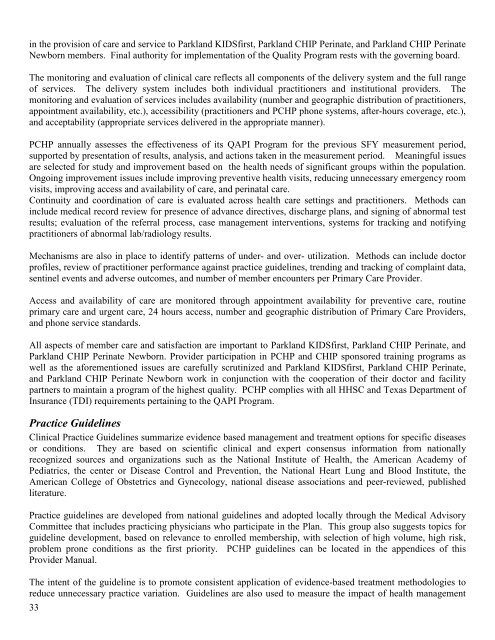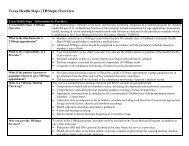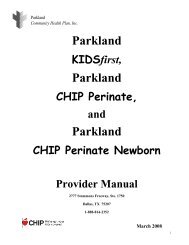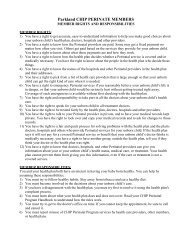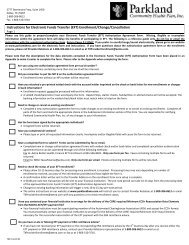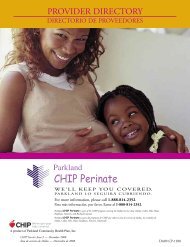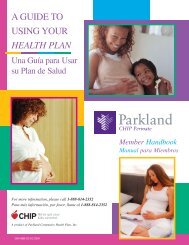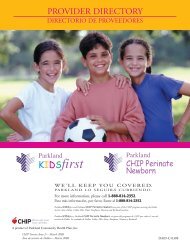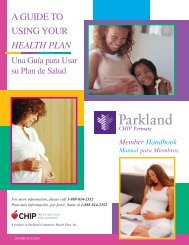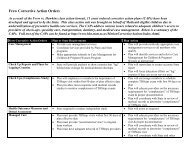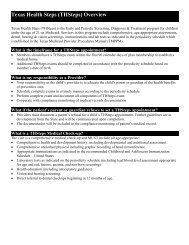PARKLAND HEALTHfirst - Parkland Community Health Plan, Inc.
PARKLAND HEALTHfirst - Parkland Community Health Plan, Inc.
PARKLAND HEALTHfirst - Parkland Community Health Plan, Inc.
You also want an ePaper? Increase the reach of your titles
YUMPU automatically turns print PDFs into web optimized ePapers that Google loves.
in the provision of care and service to <strong>Parkland</strong> KIDSfirst, <strong>Parkland</strong> CHIP Perinate, and <strong>Parkland</strong> CHIP Perinate<br />
Newborn members. Final authority for implementation of the Quality Program rests with the governing board.<br />
The monitoring and evaluation of clinical care reflects all components of the delivery system and the full range<br />
of services. The delivery system includes both individual practitioners and institutional providers. The<br />
monitoring and evaluation of services includes availability (number and geographic distribution of practitioners,<br />
appointment availability, etc.), accessibility (practitioners and PCHP phone systems, after-hours coverage, etc.),<br />
and acceptability (appropriate services delivered in the appropriate manner).<br />
PCHP annually assesses the effectiveness of its QAPI Program for the previous SFY measurement period,<br />
supported by presentation of results, analysis, and actions taken in the measurement period. Meaningful issues<br />
are selected for study and improvement based on the health needs of significant groups within the population.<br />
Ongoing improvement issues include improving preventive health visits, reducing unnecessary emergency room<br />
visits, improving access and availability of care, and perinatal care.<br />
Continuity and coordination of care is evaluated across health care settings and practitioners. Methods can<br />
include medical record review for presence of advance directives, discharge plans, and signing of abnormal test<br />
results; evaluation of the referral process, case management interventions, systems for tracking and notifying<br />
practitioners of abnormal lab/radiology results.<br />
Mechanisms are also in place to identify patterns of under- and over- utilization. Methods can include doctor<br />
profiles, review of practitioner performance against practice guidelines, trending and tracking of complaint data,<br />
sentinel events and adverse outcomes, and number of member encounters per Primary Care Provider.<br />
Access and availability of care are monitored through appointment availability for preventive care, routine<br />
primary care and urgent care, 24 hours access, number and geographic distribution of Primary Care Providers,<br />
and phone service standards.<br />
All aspects of member care and satisfaction are important to <strong>Parkland</strong> KIDSfirst, <strong>Parkland</strong> CHIP Perinate, and<br />
<strong>Parkland</strong> CHIP Perinate Newborn. Provider participation in PCHP and CHIP sponsored training programs as<br />
well as the aforementioned issues are carefully scrutinized and <strong>Parkland</strong> KIDSfirst, <strong>Parkland</strong> CHIP Perinate,<br />
and <strong>Parkland</strong> CHIP Perinate Newborn work in conjunction with the cooperation of their doctor and facility<br />
partners to maintain a program of the highest quality. PCHP complies with all HHSC and Texas Department of<br />
Insurance (TDI) requirements pertaining to the QAPI Program.<br />
Practice Guidelines<br />
Clinical Practice Guidelines summarize evidence based management and treatment options for specific diseases<br />
or conditions. They are based on scientific clinical and expert consensus information from nationally<br />
recognized sources and organizations such as the National Institute of <strong>Health</strong>, the American Academy of<br />
Pediatrics, the center or Disease Control and Prevention, the National Heart Lung and Blood Institute, the<br />
American College of Obstetrics and Gynecology, national disease associations and peer-reviewed, published<br />
literature.<br />
Practice guidelines are developed from national guidelines and adopted locally through the Medical Advisory<br />
Committee that includes practicing physicians who participate in the <strong>Plan</strong>. This group also suggests topics for<br />
guideline development, based on relevance to enrolled membership, with selection of high volume, high risk,<br />
problem prone conditions as the first priority. PCHP guidelines can be located in the appendices of this<br />
Provider Manual.<br />
The intent of the guideline is to promote consistent application of evidence-based treatment methodologies to<br />
reduce unnecessary practice variation. Guidelines are also used to measure the impact of health management<br />
33


